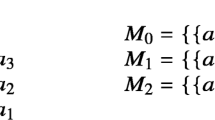Abstract
The performance of the Gale–Shapley marriage matching algorithm (Am Math Mon 16:217–222, 1962) has been studied extensively in the special case of men’s and women’s preferences random. We drop the assumption that women’s preferences are random and show that \({R_n/n\ln n\rightarrow 1}\) , where R n is the men’s expected level of satisfaction, that is, the expected sum of men’s rankings of their assigned mates, when the men-propose Gale–Shapley algorithm is used to match n men with n women. This is a step towards establishing a conjecture of Knuth (Mariages Stables et leurs relations avec d’ autres problémes combinatoires, 1976, CRM Proceedings and Lecture Notes, Vol 10, 1997) of 30 years standing. Under the same assumptions, we also establish bounds on the expected rankings by women of their assigned mates.
Similar content being viewed by others
References
Caldarelli G, Capocci A (2001) Beauty and distance in the stable matching problem. Physica A 300: 325–331
Chen Y, Sönmez T (2002) Improving efficiency of on-campus housing: an experimental study. Am Econ Rev 92: 1669–1686
Demange G, Gale D, Sotomayor MA (1987) A further note on the stable matching problem. Discret Appl Math 16: 217–222
Gale D, Shapley LS (1962) College admissions and the stability of marriage. Am Math Mon 69: 9–15
Knuth DE (1976) Mariages Stables et leurs relations avec d’ autres problémes combinatoires. Les Presses de l’ Université de Montréal, Montréal
Knuth DE (1997) Stable marriage and its relation to other combinatorial problems. In: CRM proceedings and lecture notes, vol 10. American Mathematical Society
McVitie DG, Wilson LB (1971) Three procedures for the stable matching problem. ACM Algorithm 411. Comm ACM 14: 491–492
Pittel B (1989) The average number of stable matchings. Soc Ind Appl Math 2: 530–549
Roth AE, Sönmez T, Ünver MU (2004) Kidney exchange. Q J Econ 19: 457–488
Roth AE, Vande Vate JH (1991) Incentives in two-sided matching with random stable mechanisms. Econ Theory 1: 31–44
Roth AE, Sotomayor MA (1990) Two-sided matching: a study in game theoretic modeling and analysis. Econometric Society Monographs, No. 18. Cambridge University Press
Wilson LB (1972) An analysis of the marriage matching assignment algorithm. BIT 12: 569–575
Author information
Authors and Affiliations
Corresponding author
Rights and permissions
About this article
Cite this article
Knoblauch, V. Marriage matching and gender satisfaction. Soc Choice Welf 32, 15–27 (2009). https://doi.org/10.1007/s00355-008-0303-2
Received:
Accepted:
Published:
Issue Date:
DOI: https://doi.org/10.1007/s00355-008-0303-2




